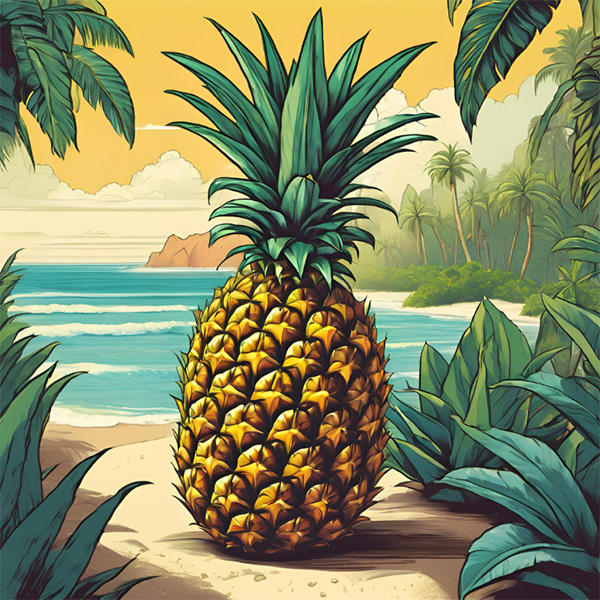Read by Michael Flamel

A Juicy History
The pineapple, a fruit that instantly evokes images of tropical paradises, has a rich and fascinating history. Originating in South America, particularly in the region that is modern-day Paraguay and Brazil, the pineapple was first encountered by Europeans when Christopher Columbus arrived in the Caribbean in 1493. He brought this curious fruit back to Europe, where it became an instant sensation.
In the 16th and 17th centuries, the pineapple was a symbol of wealth and prestige. It was so rare and valuable that owning a pineapple was akin to owning a treasure. European aristocrats and royalty would display pineapples at their lavish feasts to impress their guests. Growing pineapples in the cold climate of Europe was a challenge that required the invention of hothouses, early greenhouses that were heated and carefully managed to simulate the tropical environment. These “pineries” were a testament to both the wealth and horticultural prowess of their owners.
Tropical Delight to Global Staple
Today, pineapples are no longer reserved for the elite. They are grown in tropical regions around the world, including Hawaii, the Philippines, Thailand, Costa Rica, and parts of Africa. The largest producers, Costa Rica and the Philippines, contribute significantly to the global supply.
Growing pineapples is an intriguing process. The plant itself is part of the bromeliad family and takes about 18-24 months to produce a single fruit. Pineapples are grown from the crown of the fruit, which is planted in the soil and nurtured in warm, sunny climates. Once the fruit is harvested, it is swiftly transported by sea and air to supermarkets worldwide, ensuring that we can enjoy fresh pineapple no matter where we are.
Fun Facts About Pineapples
Luxury Status: In colonial America, a single pineapple could cost as much as $8,000 in today’s money due to its scarcity and the difficulty of transporting it.
Long Growth Period: It takes up to two years to grow one pineapple, a testament to the care and patience required in its cultivation.
Botanical Family: Pineapples are part of the bromeliad family, which includes both edible and non-edible relatives.
Pineapple in the Kitchen
Pineapple is a versatile fruit used in a myriad of ways across different cuisines. In America, it shines in dishes like pineapple upside-down cake, ham with pineapple glaze, and the controversial yet beloved Hawaiian pizza. In Europe, pineapple often graces fruit salads and desserts, while in Asia, it’s a key ingredient in sweet and sour dishes and is commonly found in tropical fruit mixes.
Each culture brings its own twist to the use of pineapple:
Thailand: Known for the spicy and tangy pineapple fried rice.
India: Pineapple is used in refreshing chutneys and savory curries.
Hawaii: Home to the famous pineapple-topped Huli Huli chicken and the refreshing Dole Whip.
Pineapple as a Symbol
Beyond its culinary uses, the pineapple has a rich cultural significance, especially in New England, where I live. Here, the pineapple is a symbol of welcome and friendship. This tradition dates back to the colonial period when returning sea captains would place a pineapple on their gateposts to signal their safe return and to invite friends to share in their bounty. This custom has endured, and you can still find pineapples in New England architecture and decor, symbolizing hospitality.
A Taste of the Tropics
My own experiences with pineapple have taken me from the sunny shores of the Caribbean to the lush landscapes of Hawaii. There’s nothing quite like enjoying a freshly cut pineapple in its native tropical habitat—it’s sweet, juicy, and incredibly refreshing. Unfortunately, back home in New England, it’s rare to find a pineapple that matches the perfection of those tropical varieties. Nevertheless, the pineapple remains a beloved fruit, a reminder of sunny vacations and a welcome symbol in our homes.
Whether you’re savoring a slice on a Summer day, cooking up a tropical-inspired dish, or simply enjoying the pineapple’s bright and cheerful presence, this fruit continues to be a delightful part of our lives. From its rich history to its journey across the world, the pineapple remains a testament to nature’s ability to surprise and delight us. ❖


 Previous
Previous

